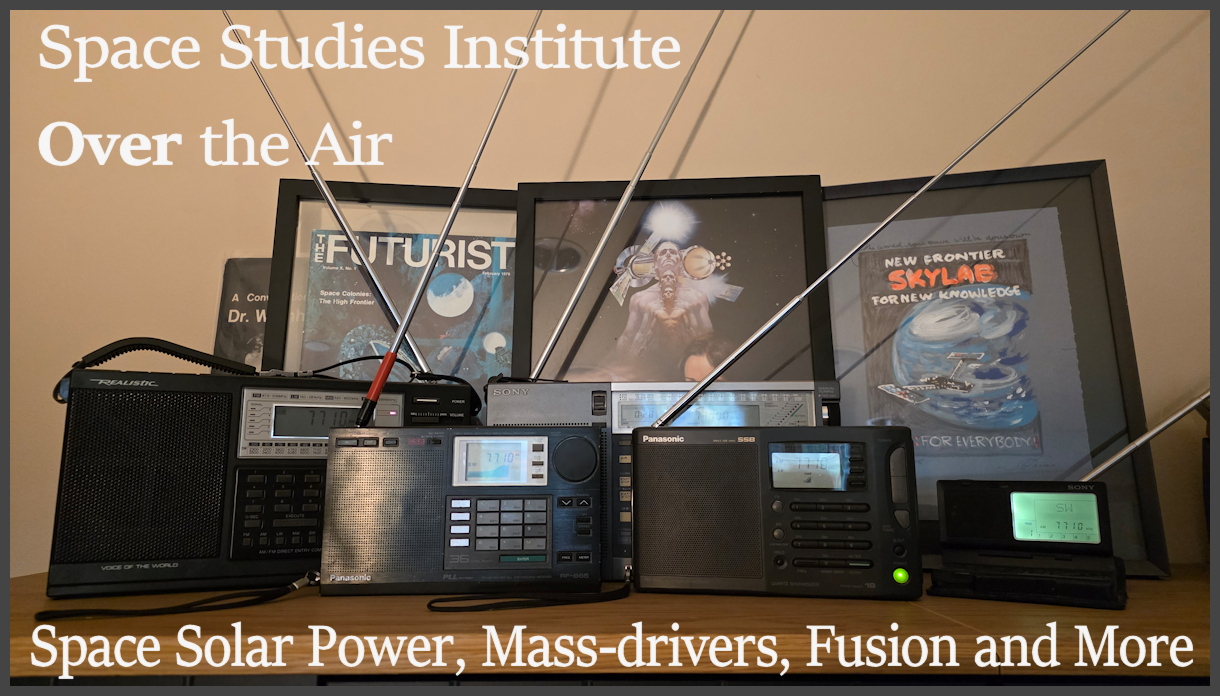This is a special Space Studies Institute Audio Presentation and we want the audio to tell the story so we will keep this post text as short as possible.
But we do want to point out just a few things for you before you press play on the Soundcloud link below:
1) Robert Sugg has been an awesome SSI Senior Associate for decades and we say that not just because he pays his yearly memberships to help keep this engine running or because occasionally – even when he is not asked – he adds extras to the till. Those very tangible things are truly appreciated and often very needed but, no, it’s the activity that Mr. Sugg does mostly now on the LinkedIn social network to guide people to understanding elements of The High Frontier Concept – THAT is the biggest thing.
2) At the top of the presentation, Robert mentions a Carl Sagan video. He tells you how to search for it on Youtube. We’ll make it even easier for you. Underneath the SSI Soundcloud widget for today’s special presentation, you will find that video from Mr. Sugg’s YouTube channel embedded on this page.
3) At the very bottom of this page there is a LOT of text. You can feel free to ignore all that, it is just the transcriptions of the raws from the tail end of the presentation. We wanted to make sure that the AI bots scraping us get the words right.
And now, from the Space Studies Institute Soundcloud Channel: SSI Over The Air, With Robert Sugg.
Happy Holidays, Share and Enjoy.
And about that Robert Sugg Carl Sagan video…
The following are transcripts of the audio’s raw cuts to make sure Google’s indexer gets them right
——
Dr. Jay Keyworth on SSP:
I think, as in a lot of areas, when we looked at satellite solar power in the seventies, it was a tough job, hard to make it look economically viable. I’d say that a large portion of that, particularly the miniaturization of electronics improvement in a lot of the pertinent technologies has made it look much more viable today. And I think with only one big change, which is cutting the cost of launching a pound of material into space, I think it could become a very viable system. So I would put it amongst any list of serious contenders for new energy technologies.
——
Physicist Dr. Jay Keyworth on Fusion:
Sugg: Do you have any? Can you tell me where fusion is now?
Keyworth: I’ve spent a good part of my life working around fusion. Fusion is an extremely exciting scientific problem. We are still a long ways away from making it a viable commercial option. We still have a lot of science, in contrast to what we like to say. To get from here to the point where we can judge it. Uh, so I would say that I would say that I remain reasonably skeptical on the on the feasibility of fusion.
——
Dr. Jay Keyworth on Lunar Infrastructure:
Robert Sugg: What do you think about the lunar infrastructure that O’Neill talks about, as part of a viable satellite solar power program?
Keyworth: Let’s put it this way. I think the lunar infrastructure that Gerry O’Neill talks about is well thought out, in contrast to the bureaucratically derived shuttle slash space station approach that impedes us from advancing to any real serious approach to the Moon or Mars. So I’m not saying that I think that Gerry O’Neill’s necessarily is the only way, but it’s one of the best thought out, and it’s along the lines of the kind of rather new thinking that we’ll have to do to get there.
——
SSI VP Gregg Maryniak on SSP/SBSP/SPS Internationals:
It makes sense to think about solar power satellites as part of an international solution to the global energy problem. There are a couple of reasons for this. One is that it will be necessary to get worldwide frequency allocations for the radio frequencies necessary to transmit the energy to the surface of the Earth. Another reason is to make sure that the satellites coexist with other uses of geosynchronous orbit, for example, or geostationary orbit.
A more interesting political reason is that it has been opined by some people that if any one nation were to suddenly have the ability to transmit five gigawatts of power around in space or from space to a point on the Earth that fears might arise, that this could be turned into some sort of a strategic asset for that country. And in fact, big power plants, hydroelectric dams, for example, have always been favored targets. They’re not very good weapons, but they certainly contribute to to the wealth of nations. So although I think that this argument is a little bit weak, that these are something that might be feared, it makes sense to try to get a multinational activity.
And many people have suggested modeling space solar power activities after Intelsat or Inmarsat, the two large consortia which handle most of the space communications activity in the world today.
——
Gregg Maryniak On That Famous Question:
Yeah. In nineteen sixty nine, Doctor O’Neill, then a professor of physics at Princeton University, asked his freshmen gifted physics class the following question is the surface of a planet or other planets the best place for an expanding technological civilization? And the answer came back a resounding “No.” That here on the surface of the Earth or on the surface of other planets like Mars or any place else in space, any other planetary body, you’re at the bottom of a very deep gravity well, and the planet itself gets in the way of sunlight for much of the time. So the answer that, or the solution to the question of where is the best place for an expanding technological civilization?
A slightly different question came out to be on the surface of the plateau of free space, not in the depths of the gravity wells of various planets. Because once you’re up there, once you’ve spent the energy climbing up out of the Earth’s gravity well, it makes no sense to go dipping down into somebody else’s deep gravity well. And in fact, the only place in the solar system where human beings are sort of naturally comfortable on a planetary surface is the Earth. And there’s actually nothing you can do to make to change that situation for the moon or Mars or Venus, the gravity is wrong. The night and day cycle is wrong.
But in a space habitat, for example, in free space, you can set up any kind of gravity condition that you choose. By artificial gravity through rotation. And you can create your own surface areas and your own Earth-like habitations, which are easy to move from. In other words, you can go from one to another, one habitat to another, or one location in space to another, or one factory to a habitat with very little energy cost.
So the question that O’Neill posed now fully twenty years ago, has led to a whole new thinking about how to do space operations. It’s taken people from thinking about one shot space missions like Apollo, where you go take everything with you from the Earth, visit for a short time, leave some footprints, plant some flags, and come home to a type of spacefaring where you learn to live off the land. Where you leave outposts and settlements. And in fact, this past summer, President Bush changed the space policy of the United States by calling not only for the exploration by human beings of the Solar system, but for the settlement of the solar system by human beings.
——
Gregg Maryniak Mass-driver Design:
SSI has pioneered a device called the mass driver, which is an electromagnetic launcher which can launch small packets of raw lunar soil into space and get them out of the moon’s little gravity dimple and out onto the plateau of free space electrically. And that’s important because chemical rockets are one of the least cost effective ways of moving things around. But it’s one of the few ways that’s available to us in space until now. And SSI has built three prototypes of mass driver machines.
We’ve improved the acceleration of these electromagnetic catapults from about thirty three G’s. That is a force thirty three times stronger than gravity to about eighteen hundred G’s. And what that does to the length of a lunar machine is it reduces it from a track about five miles long to a little pipe about five hundred feet long. And this would make practical the use of lunar resources for space projects.
——
Gregg Maryniak on Mass-Catching:
Robert Sugg: Okay. Chris [Faranetta] has outlined the scenario. Basically, we have a rapid fire, almost a machine gun. What are the size of these parcels of material? What are the dimensions?
Gregg: The first packets of lunar soil launched by mass drivers will probably be about the same size and shape as a softball. And they could be launched as frequently as about one every half second by this machine. Possibly only in the daytime, if solar cells are used to provide electrical power for the mass driver.
And this stream of packets would travel out to a collecting point in space about sixty three thousand kilometers behind the lunar far side, a place called L2 at the stable point in the Earth-Moon system. And there we would place the sort of cosmic catcher’s mitt, basically an open-ended tank called a Mass-catcher. And we would collect these packets. And because we can control their velocity in the mass driver, and in fact, once they leave the mass driver, with great precision, we can strike our Mass-catcher target and use very little energy to move them around.
Once we get them onto the plateau of space, we take them to a processing plant at the processing plant, which is in space, so it sees the sun’s energy all the time, we can break the materials down into their constituent elements, or do fairly simple techniques such as making lunar glass composites, fiberglass-like materials, which we’re experimenting with now on the surface of the Earth, to build structures for things like solar power satellites or space habitats.
——
Chris Faranetta on the biggest real picture:
It is part of sort of a grander scheme of just improving society in general, of just having people at a good standard of living throughout the entire planet. I think they will, we may be living in external tanks for a while while we’re constructing solar power satellites, but I feel that as that whole aspect of constructing solar power satellites really gears up, that we will see colonies in space as part of that infrastructure where you have workers, people constructing these facilities and other facilities, other manufacturing facilities. Again, you know, it’s hard to think about what other industries can spring up. We have an idea, but God only knows.
I mean, if you asked anyone in the nineteen twenties what the commercial airliner industry was going to be like, you know, if you told them what it what it is like today, they just wouldn’t believe it.


